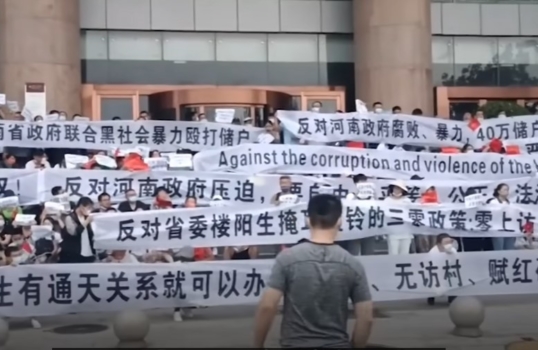China’s Hidden Debt Crisis
Editors’ Note: It is estimated that 70% of the household worth of the Chinese people is invested in the property market. This market is largely run by the government, the Communist Party, and its state-owned banks. We have covered this ongoing story for some time but indications are the situation is getting worse and has spread well beyond the collapse of Evergrande. In part, this is because of the global economic slowdown, and it further has been aggravated by draconian Covid-related lockdown policies in China. The most recent Economist suggests the problem is now political, with widespread unrest. President Xi is up for”reelection” at what could be a very difficult time. Furthermore, the crisis has taken the form of banks freezing accounts, which has created riots, as well as property owners going on strike and refusing to make their payments. As the article below indicates, China is not only highly centralized, which creates concentrated economic error on a vast scale, it is incredibly over-leveraged. Falling asset prices endanger the loans used to support the particular asset in question, which runs the risk of a cascading scramble to get out and get liquid. This, in turn, runs the risk of a deflationary bust, and then particularly in authoritarian governments, a response by governments to try to stem deflationary pressures. Knowing the timing of such events is largely impossible, but history certainly provides ample examples of the general process. What is very clear is that you can’t have the world’s second-largest economy get into such trouble, Europe lurch into trouble because of energy mistakes, and Japan experience a currency crisis (Yen is down nearly 30%); without raising the risk of global economic trauma. Meanwhile here in the US, the FED is raising rates against our own asset bubble, increasing the risk of recession here as well.
Beijing’s centralized planning has created a massive bubble of obligations.
China’s ongoing debt crisis has experienced yet another twist of fortune. Some Chinese, fearful that their savings are in jeopardy, have protested so actively in front of banks that the Peoples’ Liberation Army has intervened. Others who had bought apartments before now-troubled developers could construct them—what the Chinese refer to as presales—have threatened to withhold payments on their mortgages. These latest aspects of China’s financial troubles have captured the media’s immediate attention, but they change nothing substantive in China’s underlying problem. Significant debt overhang points to fundamental, even systemic flaws in the Chinese Communist Party’s approach to economic organization.
China’s rolling debt crisis broke in 2021, when the huge property developer, Evergrande, announced that it could no longer support some $300 billion in liabilities. Evergrande, and other developers who have since made similar if less grand announcements have left bondholders and lending banks—both private and state-owned—with assets that are now worthless, causing some to try to lock down deposits, and bringing on protests from anxious savers. Would-be homeowners who paid for and floated mortgages for apartments that do not exist have been left holding the bag. In a pattern common to financial crises everywhere, these mortgagees and lenders may now fail on other obligations, imposing losses on others who had nothing to do with the initial failure.
The government in Beijing, as well as media outlets—both Chinese and western—have so far laid the blame for these debt problems on the profligacy of Chinese developers. There can be little doubt that many of these firms had flamboyant managements that borrowed too heavily and spent too freely. But if imprudent management can take some of the blame, the lion’s share belongs to policymakers in Beijing. It was, after all, they who gave property development pride of place in the nation’s growth model. Beijing used special bonds to encourage provincial governments to work with private developers to raise whole cities from what were previously farmers’ fields.
Early on, these rapid developments formed the basis of glowing western media reports. Property development became a huge part of China’s gross domestic product (GDP). But Beijing’s planners, insensitive to facts on the ground, as central planners frequently are, went far beyond the nation’s needs. Today, Beijing estimates that some 20 percent of China’s housing stock is unoccupied and paying no return on the huge debt load incurred to produce these units. It should be no mystery, then, that the developers cannot service those obligations.
If the real estate problem were the whole story, it would be dangerous enough, but the problem is more fundamental. Beijing’s top-down, centrally planned approach to economics has multiplied these kinds of mistakes across the economy. True, this centrally planned system once worked well, but China has changed since those halcyon days, making the centralized approach increasingly wasteful and debt-prone.
When China began its decades-long growth surge, its underdeveloped state made central planning easy. All Beijing needed to do was look at the developed world and see that China lacked roads, ports, rail links, housing, and other such obvious essentials. That emphasis paid off handsomely as the nation filled in its blanks. But as China’s economy has developed and, in many ways, caught up to the developed west and Japan, future avenues for sustained growth have become harder and harder to identify. China’s planners have accordingly begun to make more and more mistakes, setting priorities that, like residential development, have increasingly missed the economy’s needs—bridges, rail links, roads to nowhere, and impressive transit systems in cities with relatively few residents. Even as such fundamentally wasteful projects are abandoned or razed, the debt incurred to build them remains.
Of course, unplanned, market-based systems also make mistakes about future needs. No one can see the future. But the mistakes of market systems are seldom as massive or pharaonic as in China’s centrally planned system. Market-based participants, typically more sensitive than are central planners to signals from buyers, adjust more quickly before going too far down the wrong road. Because the decentralization in market-based approaches implicitly creates a great diversity of efforts to capture the future, each mistake happens on a smaller scale than when central planners marshal national economic and financial resources toward relatively few priorities. The same diversity of market-based systems means that one of the many efforts to capture the uncertain future will likely be right, thereby generating great returns for the firms and individuals involved, but also crucially for the economy at large. Central planners, on the other hand, place relatively few but very large bets, and suffer commensurately when they fail to pay off. It is noteworthy that America’s market-based system has suffered its worst collapses when government intervenes, as for instance when Washington pressured banks to lend mortgage money to lesser credits, fostered dubious financial practices, and encouraged the overbuilding that culminated in the 2008 and 2009 financial crisis.
A comparison of relative debt loads in China and the United States can quantify this crucial difference and assay China’s essential problem. To be sure, Beijing has kept a lid on government debt issuance—certainly much better than Washington has. But central government debt is an inadequate measure of this effect. The financial legacy of failed projects lies with China’s provincial and local governments and the state-owned enterprises (SOEs) that control the bulk of the nation’s industry. To see the errors wrought by China’s system and make a valid comparison to the United States, the debt to track is a combination of central government obligations, provincial (or state) and local obligations, and the debt of the corporate sector.
During the ten years from 2009 to 2019, aggregate debt in China grew at a 23 percent annual rate, far in excess of the nominal economy’s otherwise impressive 8 percent growth rate. This difference offers a rough (admittedly very rough) estimate of the burden of waste left by the mistakes of the top-down planners. The equivalent debt aggregate for the United States shows a legacy of error, but on a much less grand scale. In America, this measure of debt has grown at about 5.6 percent a year over the ten years ended in 2019, faster to be sure than the 4 percent average growth of the nominal economy, but a much narrower gap than in China. The relative burden of these legacies is apparent in debt levels relative to the overall economy. In the United States, this composite of debt outstanding amounts to just over 190 percent of GDP. In China, aggregate debt verges on 270 percent.
None of this is to forecast a collapse in China or eventual American triumph. To paraphrase Adam Smith, counties can withstand a lot of ruin. What it does say is that China’s underlying economic system will for the foreseeable future create an ever-larger debt overhang. The planners may still get lucky from time to time, but the odds point in the direction of more mistakes, raise questions about easy and popular forecasts of eternal Chinese dominance and should take the edge off equally popular fear-mongering over China.
*****
This article was published by The American Mind and is reproduced with permission.




